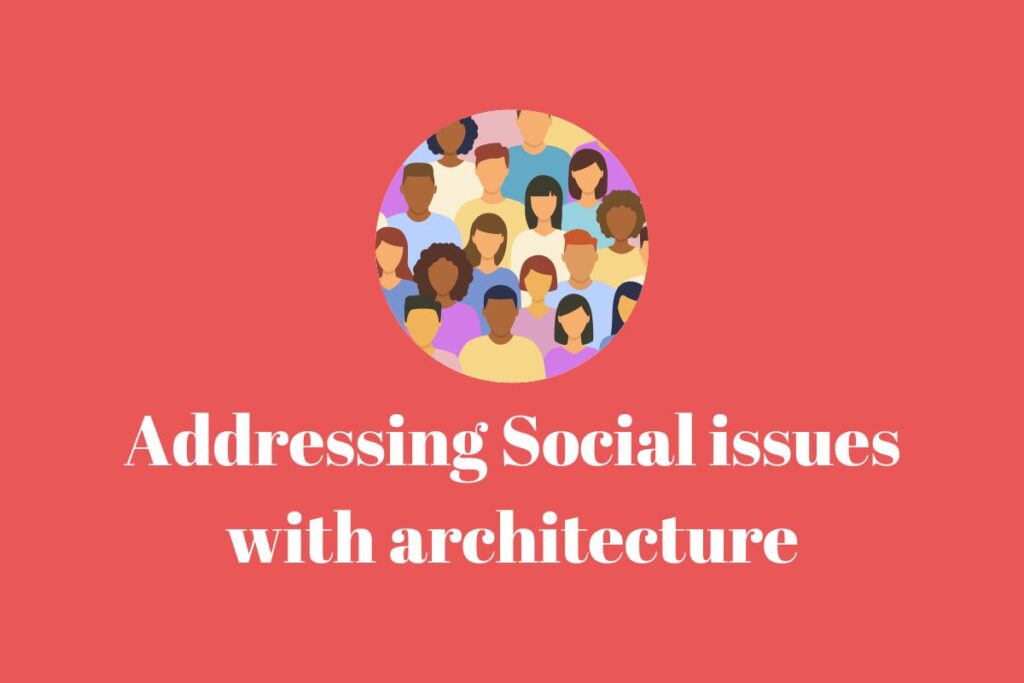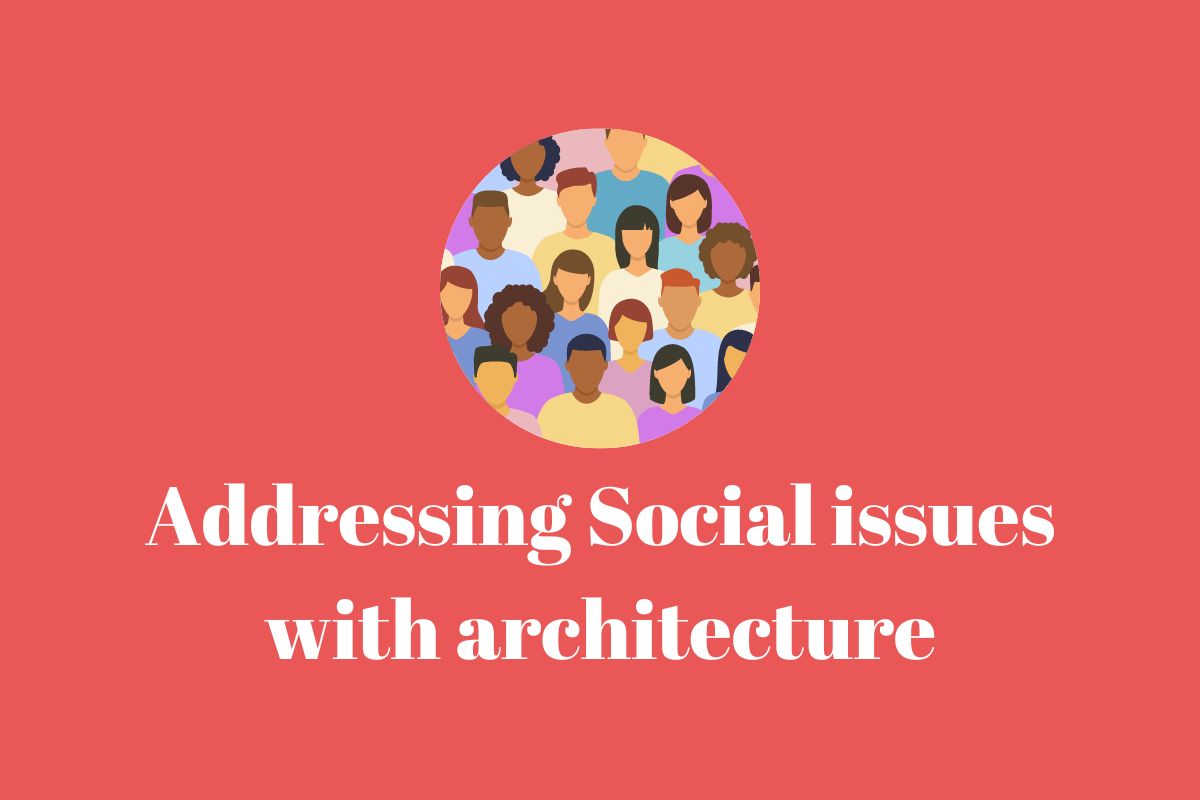
Are you a student planning for an architecture thesis on social issues? In this blog post, we’ve curated a list of 10 inspiring architecture Thesis on Social Issues. These topics offer the opportunity to showcase your design skills. And at same time allow you to make a positive impact on communities and society. From affordable housing solutions to inclusive public spaces, each topic explores the intersection of architecture and social change. Join us as we delve into these thought-provoking ideas that will ignite your creativity and help you create a lasting impact through your architecture thesis on social issues.
Empowering Communities with architecture thesis on social issues
1. Designing Community Centers as Catalysts for Social Change :
Designing community centers as catalysts for social change involves creating spaces that foster social connections, empowerment, and collective action. Community centers can be transformative when they address social, cultural, economic, and environmental issues through intentional design and programming. Here’s how they can act as catalysts for social change:
Inclusive Design: Incorporate universal design principles to make the space accessible and welcoming to all, including people with disabilities and from diverse cultural backgrounds.
Fostering Social Interaction: Design open, communal spaces that encourage collaboration and socializing through community-driven programs such as workshops, cultural events, and public forums.
Empowerment Through Education: Offer vocational training, civic education, and skill-building programs to empower individuals, especially marginalized populations, to improve their economic and social standing.
Health and Well-being: Provide access to fitness programs, mental health counseling, nutrition workshops, and healthcare services to promote community well-being.
Sustainability and Resilience: Implement green building practices and create spaces for disaster preparedness training to promote environmental awareness and community resilience.
Bridging Social Divides: Encourage inclusion and social cohesion through diverse programming and conflict resolution efforts that bring different social groups together.
Economic Empowerment: Stimulate local economies by offering co-working spaces, organizing local markets, and supporting entrepreneurship and small business development.
Technological Access: Provide access to computers, internet, and digital literacy programs to bridge the digital divide and enhance opportunities for education and employment.
Community Ownership: Engage the community in decision-making and volunteer opportunities to ensure the center reflects local needs and fosters long-term sustainability.
Also read Steps to write a high scoring architectural thesis
Reimagining Homelessness with architecture thesis on social issues
2. Innovative Design Approaches for Homeless Shelters:
An architecture thesis on social issues like homelessness should explore innovative design approaches that prioritize dignity, safety, and well-being for shelter residents. Addressing both immediate needs and long-term social reintegration, the design of homeless shelters must go beyond basic functionality to become transformative spaces.
- Modular and Flexible Design: Modular architecture allows for adaptable spaces that can be reconfigured based on the needs of the shelter residents. Prefabricated units or modular housing can be quickly assembled, offering privacy while maintaining flexibility to accommodate varying family sizes or personal circumstances.
- Trauma-Informed Design: Many homeless individuals have experienced trauma, making it essential to create environments that promote psychological safety. This includes ample natural light, open communal areas that encourage social interaction, and quiet zones for relaxation. Attention to acoustics, privacy, and sensory control can reduce stress and anxiety.
- Sustainability and Resilience: Incorporating sustainable materials and green technologies, such as solar panels and rainwater harvesting, contributes to energy efficiency and environmental stewardship. A focus on sustainability ensures that shelters are cost-effective in the long run and better integrated into the broader community.
- Health and Wellness Integration: Homeless shelters should integrate health services, including mental health support and addiction counseling. Designing spaces for physical fitness, meditation, and communal kitchens can promote holistic well-being and a sense of normalcy.
- Community-Oriented Design: Homeless shelters should connect residents to the larger community through urban integration. This could include incorporating public spaces like gardens or community centers within the shelter, fostering interaction between shelter residents and the local population, reducing stigma, and promoting social inclusion.
Innovative design in homeless shelters has the potential to not only meet basic needs but also address the deeper social issues contributing to homelessness, creating spaces that are dignified, sustainable, and supportive of long-term recovery.

Sustainable farming as a part of architecture thesis on social issues
3. Integrating Agriculture into Urban Design:
An architecture thesis on social issues focused on integrating agriculture into urban design explores how cities can address food insecurity, environmental sustainability, and community well-being. Urban agriculture merges food production with city landscapes, offering innovative solutions to social and environmental challenges.
- Rooftop Gardens and Vertical Farms: Rooftop gardens and vertical farms utilize underused urban spaces for food production. These installations reduce food miles, provide fresh produce to urban residents, and contribute to cleaner air and cooling effects in densely built environments. Their integration into commercial and residential buildings supports urban greening efforts.
- Community Gardens: Community gardens foster social cohesion by encouraging local residents to participate in food cultivation. They transform vacant lots or abandoned spaces into productive, green areas where individuals and families can grow their own food, develop a sense of ownership, and strengthen community ties.
- Edible Landscapes: Designing public parks and streetscapes with edible plants and fruit-bearing trees offers access to fresh produce while enhancing the aesthetic and ecological value of urban environments. This approach embeds agriculture into everyday life and encourages food resilience in cities.
- Mixed-Use Agricultural Developments: Mixed-use developments that integrate housing, retail, and agriculture create self-sustaining urban communities. Incorporating small-scale farms, greenhouses, or aquaponics systems into residential complexes provides direct access to local food sources, while supporting local economies and reducing reliance on industrial food systems. architecture thesis on social issues
- Policy and Social Equity: Designing urban agricultural systems requires addressing social equity by ensuring all residents have access to land, resources, and training. Urban agriculture can address food deserts, where access to fresh produce is limited, by bringing farming directly into these underserved communities.
Integrating agriculture into urban design not only promotes food security and environmental sustainability but also revitalizes communities, fosters social inclusion, and addresses systemic social issues in cities, making it a vital area of study in contemporary architecture
4. Inclusive Educational Environments
An architecture thesis on social issues that focuses on inclusive educational environments examines how thoughtful design can create equitable learning spaces for students of diverse abilities and backgrounds. Here are key design considerations for fostering inclusivity in educational settings:
- Universal Design:
- Accessibility: Incorporate features like ramps, elevators, and wide doorways to ensure physical accessibility for students with mobility impairments.
- Assistive Technologies: Integrate technology such as hearing loops, adjustable lighting, and visual aids to accommodate various sensory and cognitive needs.
- Flexible Furniture: Use adjustable desks and chairs that can be adapted for different body types and needs, promoting comfort and functionality for all students.
- Flexible Learning Spaces:
- Modular Design: Implement movable walls and furniture to allow for adaptable classroom configurations that support different teaching methods and learning styles.
- Varied Learning Zones: Design spaces with distinct areas for group work, individual study, and interactive activities. This flexibility supports diverse learning preferences and enhances engagement.
- Acoustic Treatments: Incorporate sound-absorbing materials and adjustable acoustics to cater to students who may be sensitive to noise, thus creating a more comfortable learning environment.
- Sensory-Friendly Environments:
- Calming Design Elements: Utilize soothing color schemes, natural lighting, and minimalistic decor to reduce sensory overload and create a calming atmosphere.
- Quiet Spaces: Designate areas where students can retreat for quiet, focused work or relaxation, which is beneficial for those with sensory processing disorders or attention difficulties.
- Natural Elements: Integrate nature through indoor plants, gardens, or views of the outdoors to create a tranquil and stimulating environment. architecture thesis on social issues
- Outdoor and Natural Spaces:
- Outdoor Classrooms: Incorporate gardens, courtyards, or green roofs as extensions of the classroom. These spaces offer alternative learning environments that can enhance cognitive development and provide a respite from traditional classroom settings.
- Environmental Integration: Design learning spaces that blend with the natural environment, promoting environmental awareness and offering a dynamic, immersive learning experience.
- Cultural Inclusivity:
- Reflecting Diversity: Incorporate cultural symbols, art, and multilingual signage into the design to reflect and celebrate the diverse backgrounds of the student population.
- Community Spaces: Create areas where students and their families can engage in cultural activities and events, fostering a sense of belonging and community.
- Inclusive Curriculum Support: Design spaces that support culturally relevant curricula and teaching materials, ensuring that educational content resonates with and reflects the diversity of the student body.
- Health and Well-being:
- Wellness Facilities: Include spaces for mental health support, such as counseling rooms or meditation areas, to address the emotional and psychological needs of students.
- Physical Activity: Provide access to physical activity areas, such as gyms or movement rooms, to support physical health and integrate physical activity into the school day.
- Healthy Environments: Use non-toxic materials and ensure good indoor air quality to promote the overall health of students and staff.
Integrating these design considerations into educational environments not only supports students’ diverse needs but also addresses broader social issues by fostering inclusive, equitable learning opportunities. By prioritizing accessibility, flexibility, sensory sensitivity, and cultural inclusivity, architects can create spaces that enhance the educational experience and contribute to a more just and supportive society
Transforming Abandoned Spaces with architecture thesis on social issues
5. Adaptive Reuse for Community Revitalization :
An architecture thesis on social issues exploring adaptive reuse for community revitalization focuses on repurposing existing structures to address contemporary social, economic, and environmental challenges. Adaptive reuse transforms underutilized or abandoned buildings into vibrant, functional spaces that benefit communities while preserving historical and cultural heritage. Here’s how adaptive reuse can contribute to community revitalization:
- Preservation of Historical and Cultural Assets:
- Heritage Conservation: Adaptive reuse preserves historic buildings, maintaining the architectural and cultural heritage of a community. This respect for the past fosters a sense of identity and continuity, enriching the community’s historical narrative.
- Cultural Spaces: Repurposed historical buildings can be transformed into museums, galleries, or performance spaces, celebrating local culture and history while providing venues for artistic and educational activities.
- Economic Revitalization:
- Cost-Effective Development: Reusing existing structures can be more economical than new construction, reducing costs associated with demolition, site preparation, and new building materials. This financial efficiency allows for more budget-friendly community projects.
- Local Business Opportunities: Converted buildings can host new businesses, shops, or markets, stimulating local economic activity and creating jobs. These commercial ventures attract foot traffic and contribute to the economic vitality of the area.
- Increased Property Values: Revitalizing underutilized properties can enhance the surrounding area’s appeal, leading to increased property values and attracting further investment in the community.
- Environmental Sustainability:
- Resource Efficiency: Adaptive reuse minimizes the environmental impact of new construction by repurposing existing materials and reducing waste. This approach conserves resources and lowers the carbon footprint associated with building projects.
- Energy Efficiency: Retrofitting older buildings with modern energy-efficient systems, such as improved insulation, lighting, and HVAC systems, can reduce energy consumption and lower operating costs.
- Social and Community Benefits:
- Inclusive Spaces: Reusing buildings for community centers, libraries, or affordable housing creates accessible spaces that serve diverse populations, fostering social inclusion and community engagement.
- Community Identity: Transforming abandoned or underused structures into community hubs or gathering places reinforces a sense of belonging and pride among residents, enhancing community cohesion.
- Educational Opportunities: Repurposed buildings can house educational facilities, such as vocational training centers or schools, providing valuable resources and learning opportunities for local residents.
- Urban Renewal and Placemaking:
- Revitalization of Blighted Areas: Adaptive reuse can rejuvenate neglected or deteriorated neighborhoods, turning them into vibrant, attractive places to live, work, and play. This process helps to combat urban decay and improve overall quality of life.
- Creative Placemaking: Repurposing old buildings into unique, multifunctional spaces, such as arts districts, mixed-use developments, or cultural hubs, stimulates creative placemaking and enhances the cultural and social fabric of the community.
- Design and Aesthetic Considerations:
- Architectural Integration: Effective adaptive reuse involves thoughtfully integrating new design elements with existing structures, creating cohesive and aesthetically pleasing environments that respect the original architecture while meeting contemporary needs. architecture thesis on social issues
- Community Input: Engaging local residents in the design process ensures that repurposed spaces reflect community values and preferences, fostering a sense of ownership and ensuring that the revitalized spaces meet the needs of those who will use them.
In conclusion, adaptive reuse for community revitalization offers a multifaceted approach to addressing social issues by preserving historical assets, stimulating economic growth, promoting environmental sustainability, and enhancing social cohesion. By transforming existing buildings into dynamic, functional spaces, adaptive reuse contributes to the development of vibrant, resilient communities that honor their past while embracing future possibilities.
6. Sustainable Housing for All
An architecture thesis on social issues examining sustainable housing for all focuses on creating affordable, environmentally responsible, and socially equitable housing solutions. Sustainable housing addresses both ecological concerns and social inequalities, ensuring that everyone has access to safe, healthy, and sustainable living conditions. Here are key aspects:
- Environmental Sustainability:
- Energy Efficiency: Incorporate energy-efficient systems, such as high-performance insulation, LED lighting, and renewable energy sources like solar panels, to reduce energy consumption and lower utility bills.
- Resource Conservation: Use sustainable building materials, such as recycled or rapidly renewable resources, and implement water-saving fixtures to minimize environmental impact and resource depletion.
- Green Building Standards: Adhere to green building certifications, like LEED or BREEAM, which guide the design and construction of eco-friendly homes that meet rigorous environmental performance criteria.
- Affordability and Accessibility:
- Cost-Effective Design: Utilize cost-efficient construction methods and materials to make sustainable housing affordable for low- and moderate-income families. Prefabricated or modular homes can also reduce costs and construction time.
- Inclusive Design: Ensure that sustainable housing designs are inclusive, addressing the needs of people with disabilities and incorporating universal design principles to make homes accessible to everyone.
- Health and Well-being:
- Indoor Air Quality: Prioritize non-toxic building materials and ventilation systems to enhance indoor air quality, contributing to healthier living environments and reducing the risk of respiratory issues.
- Natural Light and Ventilation: Design homes with ample natural light and cross-ventilation to improve occupants’ well-being and reduce the need for artificial lighting and air conditioning.
- Community and Social Equity:
- Equitable Access: Design sustainable housing projects that integrate affordable housing options within diverse neighborhoods, promoting social inclusion and reducing segregation.
- Community Engagement: Involve local communities in the design process to ensure that housing solutions meet their specific needs and preferences, fostering a sense of ownership and community.
Sustainable housing for all merges environmental responsibility with social equity, offering solutions that address both ecological challenges and the need for affordable, healthy living spaces. By focusing on energy efficiency, affordability, health, and community involvement, this approach creates resilient and inclusive communities
.
7. Promoting Mental Health through Healing Architecture with architecture thesis on social issues
Delve into the connection between architecture and mental health. Discover how well-designed spaces can support healing, rehabilitation, and mental well-being, and explore design strategies for therapeutic environments, such as hospitals, rehabilitation centers, and mental health facilities.

8. Creating Environments for Aging Populations:
- Address the needs of aging populations through architectural design.
- Investigate how inclusive and age-friendly communities can be created, incorporating features such as accessible housing, walkability, social spaces, and healthcare facilities to support active and independent aging.
9. Resilient Design for Climate Change
Architecture’s Role in Adaptation and Mitigation: Explore the critical relationship between architecture and climate change. Investigate design strategies that promote resilience, such as sustainable materials, energy-efficient buildings, green infrastructure, and flood-resistant design, to mitigate and adapt to the challenges of a changing climate.
Also read Disaster Management Through Architecture: 7 proven techniques
10. Integrating Formal Infrastructure in Underserved Communities :
- Address the needs of underserved communities living in informal settlements.
- Investigate design approaches that integrate formal infrastructure, including water, sanitation, electricity, and transportation
- Try to improve living conditions, social equity, and overall quality of life.
Choosing an architecture thesis on social issues allows you to contribute to positive change through your design skills. Whether it’s designing inclusive public spaces, addressing homelessness, or promoting sustainability, these topics offer opportunities to make a lasting impact on communities. As you embark on your thesis journey, consider the societal challenges that resonate with you. Conduct thorough research, and unleash your creativity. Create architecture that not only inspires but also brings about tangible social change. Together, we can use architecture as a powerful tool to shape a better and more equitable world.
Also read 20 topics to craft a winning sustainable architecture thesis

